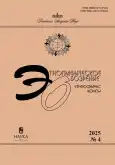Ainu Traditional Dance as an Exhibit of Museum Culture and as an Element of Ethnic Tourism
- Autores: Osipova M.V.1
-
Afiliações:
- Peter the Great Museum of Anthropology and Ethnography (Kunstkamera), Russian Academy of Sciences
- Edição: Nº 4 (2025)
- Páginas: 9-21
- Seção: Special Theme of the Issue: Ethnography of Performing Arts (guest editor S.I. Ryzhakova)
- URL: https://stomuniver.ru/0869-5415/article/view/697012
- DOI: https://doi.org/10.31857/S0869541525040025
- ID: 697012
Citar
Texto integral
Resumo
Ainu traditional dance is an integral part of folk culture, which is connected with rituals, songs and music. Nowadays, however, real rituals are not carried out and the dance that used to accompany them has turned into a cultural phenomenon which has absorbed both traditional content and new elements. Ainu dance has become a spectacular art; it is being revived and supported in museum complexes in Hokkaido, and the process of its museumification is underway. The dance is turning into a kind of museum exhibit, which requires “ethnographic accuracy” in its performance. But museums are institutions intended for the public, and they are part of the modern tourism industry. Therefore, the problem of the purposes and scope of reproducing authentic material arises. On the other hand, the dance should be spectacular and understandable to different groups of spectators. The article attempts to analyze the conditions that were instrumental in transforming the Ainu ritual dance into an exhibit of museum culture and the ways of its transition into an element of ethnic tourism.
Palavras-chave
Sobre autores
M. Osipova
Peter the Great Museum of Anthropology and Ethnography (Kunstkamera), Russian Academy of Sciences
Autor responsável pela correspondência
Email: ainu07@mail.ru
ORCID ID: 0000-0001-9486-1861
к. и. н., доцент, старший научный сотрудник отдела этнографии Сибири 3 University Emb., St. Petersburg, 199034, Russia
Bibliografia
- Глушкова П.В. Классификация музеев под открытым небом в аспекте актуализации нематериального культурного наследия // Вестник Кемеровского государственного университета. 2015. No 1 (61). Т. 1. С. 59-63.
- Каган М.С. Морфология искусства. Историко-теоретическое исследование внутреннего строения мира искусств. Ч. I-III. М.: Искусство, 1972.
- Качура А.Е. Сценическая интерпретация народного танца и его создания // Философско-культурологические исследования. 2018. No 3. http://fki.gaki. info/2018/05/02/сценическая-интерпретация-народного
- Осипова М.В. Айнский танец: от игрового к зрелищному (Очерки о танцевальной культуре айнов Сахалина, Курильских островов и о. Хоккайдо). Хабаровск: Гранд Экспресс, 2019.
- Пилсудский Б.О. На медвежьем празднике айнов // Пилсудский Б.О. Айны Южного Сахалина (1902-1905 гг.). Южно-Сахалинск: Сахалинское книжное изд-во, 2007. С. 107-206.
- Сасаки С. Кокурицу айну миндзоку хакубуцукан но сэцурицу то хатасубэки якувари (国立アイヌ民族博物館の設立と果たすべき役割 - Создание национального музея айнов и его роль) // National Ainu Museum Journal. 2022. Vol. 1. Р. 9-39. (на япон. яз.)
- Ячита М. Айну косики буё но бункадзай ситэй но икисацу ни кансуру косацу - Тири Масихо то Хонда Ясудзи но гэнко кара (アイヌ古式舞踊」の文化財指定の経緯に関する考察 - Исследование истории обозначения "традиционный айнский танец" как культурное достояние. Из рукописи Тири Масихо и Хонда Ясудзи) // National Ainu Museum Journal. 2022. Vol. 1. Р. 114-131. (на япон. яз.)
Arquivos suplementares










